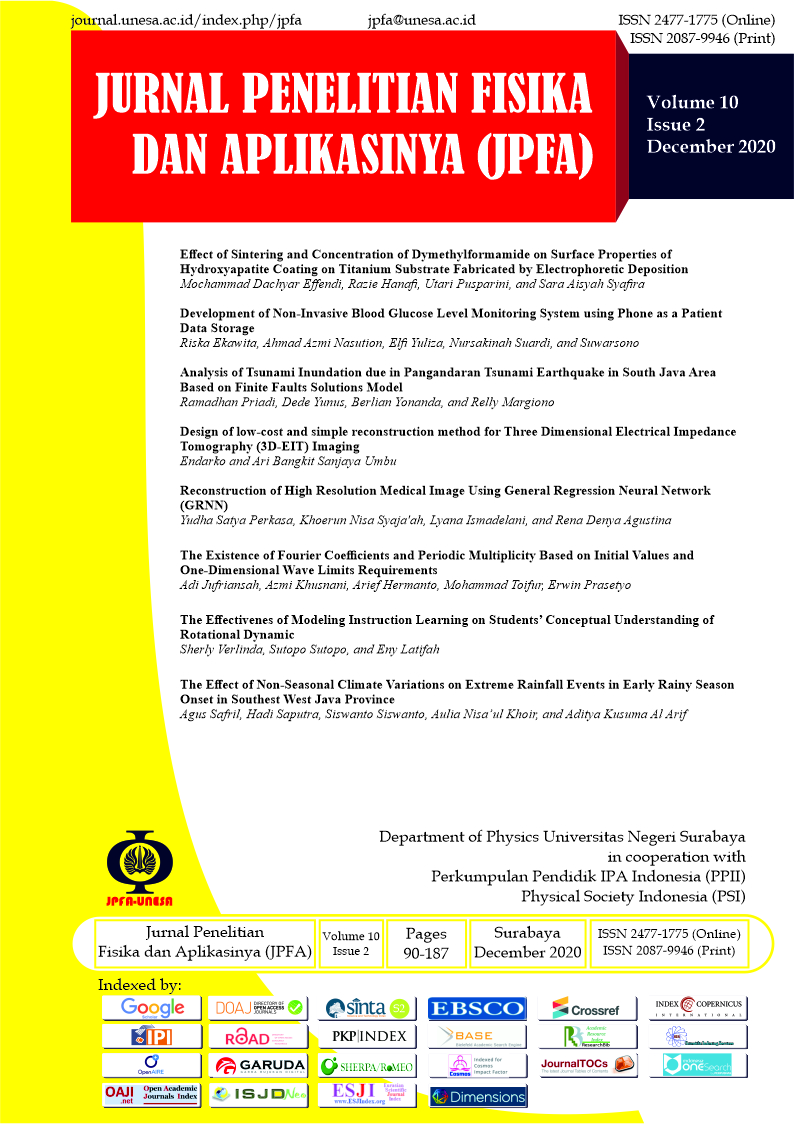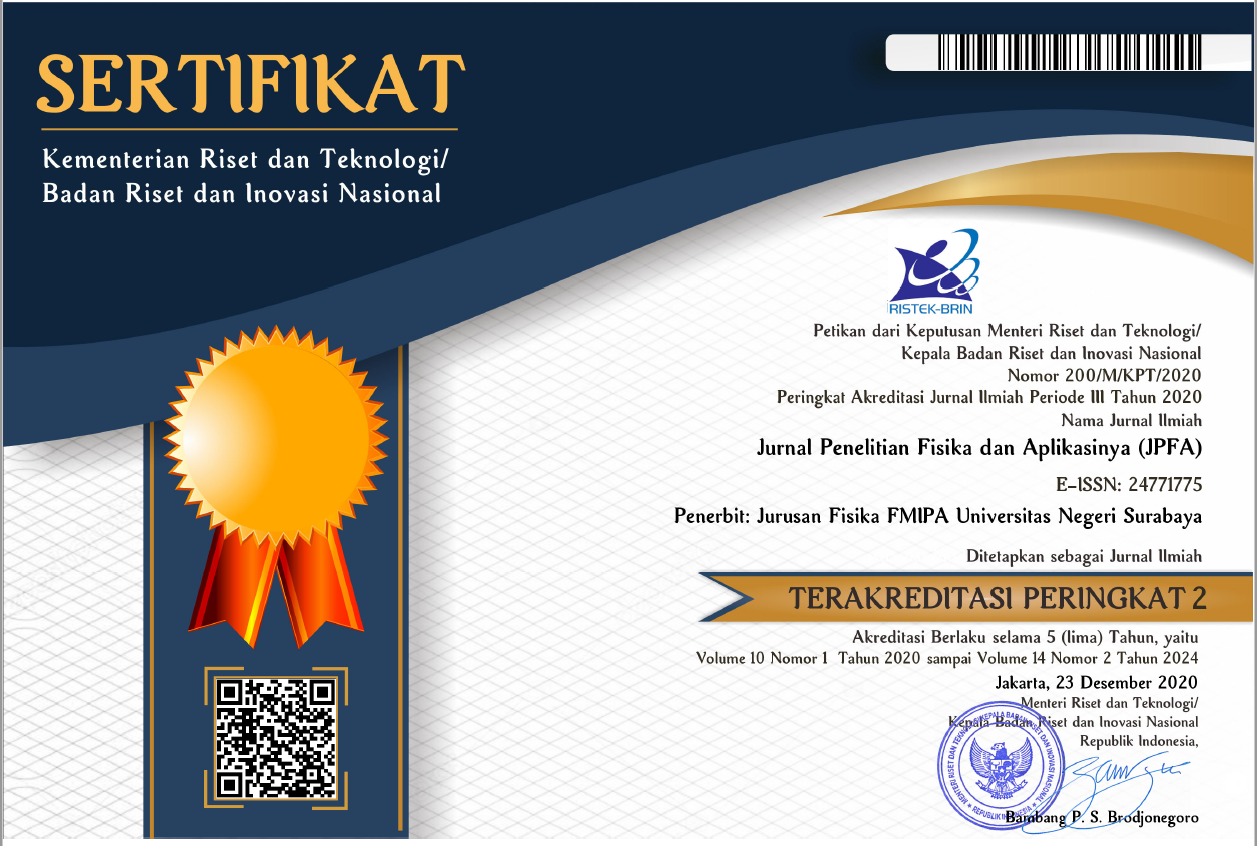Development of Non-Invasive Blood Glucose Level Monitoring System using Phone as a Patient Data Storage
DOI:
https://doi.org/10.26740/jpfa.v10n2.p103-113Keywords:
glucose, non-invasive, phone, sensor, microcontrollerAbstract
Glucose levels that accumulate in the blood can cause other organ disorders and even cause death. To prevent such occurrence, continuous and regular glucose measuring and monitoring is required for diabetes mellitus (DM) patients. Glucose measurement for DM patients are generally performed several times a day, so be required easy, harmless method of measuring the DM patients, and monitoring data are well recorded. Thus in this research, an android non-invasive glucose level system with wireless communication and automatic data storage on the phones memory was developed. The study was begun with the built of electronic and software systems as the central part of the measuring system. The electronic section consists of laser and light sensors that respond to a change in blood glucose (BG) levels, the microcontroller that controlled all of the measuring processes, and Bluetooth modules as transceiver on data communication of the android. The software section is built using an App Inventor developed by the Massachusetts Institute of Technology (MIT) to display and store data measurement on the mobile phone. The calibration process of light sensors is done with the standard tool and at last, the wireless communication systems testing and BG levels measurement. The result shows that 94 mg/dl of BG levels by standard tools equals 2.86 volts of voltage measured by the design system. The higher the BG level, the lower the voltage be. Increase the BG level causes the resistance between the transmitter and the receiver to raise and the voltage becomes low.
References
Ouyang C, Zhoub P, and Gan Z. A Non-Invasive Test Method for Type-2 Waveform Diabetes Mellitus by Pulse Fitting. Biomedical Signal Processing and Control. 2020; 60: 102000. DOI: https://doi.org/10.1016/j.bspc.2020.102000.
Zheng H, He J, Li P, Guo M, Jin H, Shen J, Xie Z, and Chi C. Glucose Screening Measurements and Noninvasive Glucose Monitor Methods. Procedia Computer Science. 2018; 139: 613-62. DOI: https://doi.org/10.1016/j.procs.2018.10.202.
Xue J, Liming Y, Chunyan L, Mingxiang Z, and Peng L. Rapid and Nondestructive Measurement of Glucose in A Skin Tissue Phantom by Near-Infrared Spectroscopy. Optik. 2018; 170: 30-36. DOI: https://doi.org/10.1016/j.ijleo.2018.05.050.
Rodin D, Kirby M, Sedogin N, Shapiro Y, Pinhasov A, and Kreinin A. Comparative Accuracy of Optical Sensor-Based Wearable System for Noninvasive Measurement of Blood Glucose Concentration. Clinical Biochemistry. 2019; 65: 15-20. DOI: https://doi.org/10.1016/j.clinbiochem.2018.12.014.
Juan CG, Bronchalo E, Torregrosa G, Avila E, Garcia N, and Navarro JMS. Dielectric Characterization Of Water Glucose Solutions Using A Transmission/Reflection Line Method. Biomedical Signal Processing and Control. 2017; 31: 139-147. DOI: http://dx.doi.org/10.1016/j.bspc.2016.07.011
Karyakin AA, Nikulina SV, Vokhmyanina DV, Karyakina EE, Anaev EKH, and Chuchalin AG. Non-Invasive Monitoring of Diabetes Through Analysis of The Exhaled Breath Condensate (Aerosol). Electrochemistry Communications. 2017; 83: 81-84. DOI: http://dx.doi.org/10.1016/j.elecom.2017.09.005.
Kim S, Melikyan H, Kim J, Babajanyan A, Enkhtur L, Friedman B, Lee K, and Lee JH. Noninvasive In Vitro Measurement Of Pig-Blood D-Glucose by Using A Microwave Cavity Sensor. Diabetes Research and Clinical Practice. 2012; 96(3): 379-384. DOI: https://doi.org/10.1016/j.diabres.2012.01.018.
Kubota T, Kubota N and Kadowaki T. Imbalanced Insulin Actions in Obesity and Type 2 Diabetes: Key Mouse Models of Insulin Signaling Pathway. Cell Metabolism. 2017; 25(4): 797-810. DOI: http://dx.doi.org/10.1016/j.cmet.2017.03.004
Sharma S, Takagi E, Cass T, Tsugawa W, and Sode K. Minimally Invasive Microneedle Array Electrodes Employing Direct Electron Transfer Type Glucose Dehydrogenase for The Development of Continuous Glucose Monitoring Sensors. Procedia Technology. 2017; 27: 208-209. DOI: https://doi.org/10.1016/j.protcy.2017.04.087.
Li J, Koinkar P, Fuchiwaki Y, and Yasuzawa M. A Fine Pointed Glucose Oxidase Immobilized Electrode for Low-Invasive Amperometric Glucose Monitoring. Biosensors and Bioelectronic. 2016; 86: 90-94. DOI: http://dx.doi.org/10.1016/j.bios.2016.06.037.
Arakawa T, Kuroki Y, Nitta H, Chouhan P, Toma K, Sawada SI, Takeuchi S, Sekita T, Akiyoshi K, Minakuchi S, and Mitsubayashi K. Mouthguard Biosensor with Telemetry System for Monitoring of Saliva Glucose: A Novel Cavitas Sensor. Biosensors and Bioelectronics. 2015; 84: 106-111. DOI: http://dx.doi.org/10.1016/j.bios.2015.12.014.
Liang Y, Wanderer J, Nichols JH, Klonoff D, and Rice MJ. Blood Gas Analyzer Accuracy of Glucose Measurements. Mayo Clinic Proceedings. July 2017; 92(7): 1030-1041. DOI: http://dx.doi.org/10.1016/j.mayocp.2017.03.009.
Budiyanto M, Yasin M and Harun SW. Sensitivity Approach of Optical Sensors of Cholesterol Detection through Gaussian Beamand Quasi-Gaussian Beam. Jurnal Penelitian Fisika dan Aplikasinya (JPFA). 2019; 9(1): 22-31. DOI: http://dx.doi.org/10.26740/jpfa.v9n1.p22-31.
Kumar N, Salehilashkajani A, Zhang HD, Ady M, Forck P, Glutting J, Jones OR, Kersevan R, Doddington TM, Mazzoni S, Rossi A, Schneider G, Udrea S, Veness R, and Welsch CP. Non-Invasive Beam Proï¬le Monitor for Medical Accelerators. Physica Medica. 2020; 74: 173-178. DOI: https://doi.org/10.1016/j.ejmp.2020.04.023.
Pandey I and Tiwari JD. A Novel Dual Imprinted Conducting Nanocubes Based flexible Sensor for Simultaneous Detection of Hemoglobin and Glycated Haemoglobin in Gestational Diabetes Mellitus Patients. Sensors and Actuators B: Chemical. 2019; 285: 470-478. DOI: https://doi.org/10.1016/j.snb.2019.01.093.
Jeong B, Jung CH, Lee YH, Shin IH, Kim H, Bae SJ, Lee DS, Kang ES, Kang U, Kim JJ, and Park JY. A Novel Imaging Platform for Non-Invasive Screening of Abnormal Glucose Tolerance. Diabetes Research and Clinical Practice. 2016; 116: 83-85. http://dx.doi.org/10.1016/j.diabres.2016.03.014.
Min X, Liu R, Fu B, and Xu K. A Preliminary Veriï¬cation of The floating Reference Measurement Method for Non-Invasive Blood Glucose Sensing. Optics & Laser Technology. 2017; 91: 7-12. DOI: http://dx.doi.org/10.1016/j.optlastec.2016.12.011.
Soni A, and Jha SK. Smartphone Based Non-Invasive Salivary Glucose Biosensor. Analytica Chimica Acta. 2017; 996: 54-63. DOI: https://doi.org/10.1016/j.aca.2017.10.003.
Huang J, Zhang Y, and Wu J. Review of Non-Invasive Continuous Glucose Monitoring Based on Impedance Spectroscopy. Sensors and Actuators A. 2020; 311: 112103. DOI: https://doi.org/10.1016/j.sna.2020.112103.
Chen Q and Tang L. A Wearable Blood Oxygen Saturation Monitoring System Based on Bluetooth Low Energy Technology. Computer Communications. 2020; 160 :101-110. DOI: https://doi.org/10.1016/j.comcom.2020.05.041.
Falco ID, Cioppa AD, Giugliano A, Marcelli A, Koutny T, Krcma M, Scafuri U, and Terantino E. A Genetic Programming-Based Regression for Extrapolating A Blood Glucose-Dynamics Model from Interstitial Glucose Measurements and Their First Derivatives. Applied Soft Computing Journal. 2019; 77: 316-328. DOI: https://doi.org/10.1016/j.asoc.2019.01.020.
Wang Y, Hu X, Tang J, Wang W, Dong L, Zhou J, and Jia W. Traceability to A Primary Reference Measurement Procedure (ID-LCMS); A key Step in Validating The Clinical Accuracy and Safety of Hospital Blood Glucose Monitoring Systems. Clinica Chimica Acta. 2018; 486: 275281. DOI: https://doi.org/10.1016/j.cca.2018.08.025.
Varady NH, Schwab PE, Jones T, Collins JE, Fitz W, and Chen AF. Optimal Timing of Glucose Measurements after Total Joint. Arthroplasty. The Journal of Arthroplasty. 2019; 34(7): S152-S158. DOI: https://doi.org/10.1016/j.arth.2019.01.004.
Ray PP, Dash D, and Kumar N. Sensors for internet of medical things: State-of-The-Art, Security and Privacy Issues, Challenges and Future Directions. Computer Communications. 2020; 160: 111-131. DOI: https://doi.org/10.1016/j.comcom.2020.05.029.
Gao L, Zhang G, Yu B, Qiao Z, and Wang J. Wearable Human Motion Posture Capture and Medical Health Monitoring Based on Wireless Sensor Networks. Measurement. 2020; 166: 108252. DOI: https://doi.org/10.1016/j.measurement.2020.108252.
Persell SD, Karmali KN, Stein N, Jim Li J, Peprah YA, Lipiszko D, Ciolino JD, and Sato H. Design of A Randomized Controlled Trial Comparing A Mobile Phone-Based Hypertension Health Coaching Application to Home Blood Pressure Monitoring Alone: The Smart Hypertension Control Study. Contemporary Clinical Trials. 2018; 73: 92-97. DOI: https://doi.org/10.1016/j.cct.2018.08.013.
Antsiperov V, Mansurov G, and Danilychev M. Non-Invasive Arterial Pressure Monitoring By A New Pneumatic Sensor and On-Line Analysis of Pulse Waveforms for A Modern Medical Home Care Systems. Procedia Computer Science. 2020; 176: 2894-2903. DOI: https://doi.org/10.1016/j.procs.2020.09.264.
Vezouviou E, Lowe CR. A Near Infrared Holographic Glucose Sensor. Biosensors and Bioelectronics. 2015; 68: 371-381. DOI: http://dx.doi.org/10.1016/j.bios.2015.01.014
Dumke CL, Slivka DR, Cuddy JS, Hailes WS, Rose SM, and Ruby BC. The Effect of Environmental Temperature on Glucose and Insulin After an Oral Glucose Tolerance Test in HealthyYoung Men. Wilderness & Environmental Medicine. 2015; 26(3): 335-342. DOI: https://doi.org/10.1016/j.wem.2015.03.002.
Hao Y, Chen YW, He XL, Yang F, Han RX, Yang CL, Li W, and Qian ZY. Near-infrared Responsive 5-Fluorouracil and Indocyanine Green Loaded MPEG-PCL Nanoparticle Integrated With Dissolvable Microneedle for Skin Cancer Therapy. Bioactive Materials. 2020; 5(3): 542-552. DOI: https://doi.org/10.1016/j.bioactmat.2020.04.002.
Havenith G and Lloyd AB. Counterpoint to œInfrared Cameras Overestimate Skin Temperature During Rewarming from Cold Exposure. Journal of Thermal Biology. 2020; 92: 102663. DOI: https://doi.org/10.1016/j.jtherbio.2020.102663.
Hsiu H, Hu HF, and Tsai HC. Differences in Laser-Doppler Indices Between Skin-Surface Measurement Sites in Subjects with Diabetes. Microvascular Research. 2018; 115: 1-7. DOI: http://dx.doi.org/10.1016/j.mvr.2017.07.004.
Khan F and Pickup JC. Near-infrared Fluorescence Glucose Sensing Based on Glucose/Galactose-Binding Protein Coupled to 651-Blue Oxazine. Biochemical and Biophysical Research Communications. 2013; 438(3): 488-492. DOI: http://dx.doi.org/10.1016/j.bbrc.2013.07.111.
Downloads
Published
How to Cite
Issue
Section
License
Author(s) who wish to publish with this journal should agree to the following terms:
- Author(s) retain copyright and grant the journal right of first publication with the work simultaneously licensed under a Creative Commons Attribution-Non Commercial 4.0 License (CC BY-NC) that allows others to share the work with an acknowledgement of the work's authorship and initial publication in this journal for noncommercial purposes.
- Author(s) are able to enter into separate, additional contractual arrangements for the non-exclusive distribution of the journal's published version of the work (e.g., post it to an institutional repository or publish it in a book), with an acknowledgement of its initial publication in this journal.
The publisher publish and distribute the Article with the copyright notice to the JPFA with the article license CC-BY-NC 4.0.
 Abstract views: 1393
,
Abstract views: 1393
, PDF Downloads: 1432
PDF Downloads: 1432









